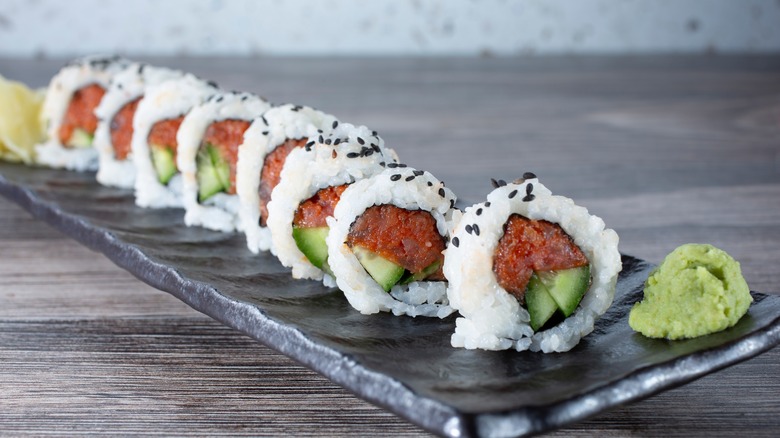Why You Might Want To Skip The Spicy Tuna Rolls At A Sushi Restaurant
Spicy tuna rolls are the superior sushi order for a reason: tuna, mayo, chili sauce, and the umami taste of nori is a combination that feels like a cheat code for immediate satisfaction. Still, there are a number of things worth knowing before you order from your favorite sushi restaurant, and sushi experts and in-the know sushi-lovers everywhere take extra caution when it comes to spicy tuna rolls. As delicious as they may be, one of the key ingredients is actually tuna scrape aka the "pink slime" of the sushi world. Tuna scrape is exactly as unpleasant as it sounds — it is the meat scraped from the skeleton of the tuna rather than the freshest, most nutritious tuna meat. Not only does this mean that the tuna is not as flavorsome and often the reason why your beloved spicy tuna roll is so heavily seasoned, but it also has been linked to some pretty serious health risks. In 2012, there was even an outbreak of Salmonella related to tuna scrape according to the Centers for Disease Control and Prevention (CDC).
While tuna is one of the most common types of fish you'll always see on sushi menus, it should only be added when safe and top quality, which is not always the case with spicy tuna rolls. Restaurants often get this type of tuna shipped as a frozen product. The tuna backmeat is also ground, a less-than-desirable form since ground meat in general presents more risk of contamination — yikes. Whether you're hooked on tuna sushi rolls or a newbie to sushi and want to test the waters with a familiar and easy-to-love tuna flavor, it's worth knowing the truth about what's actually in spicy tuna rolls and how to avoid disappointment.
How to spot good quality spicy tuna rolls
If you do wish to keep your spicy tuna rolls in rotation, there is some hope if you know what to look out for. There are some crucial telltale signs that the tuna isn't the best quality and probably worth avoiding completely. When it comes to consuming raw tuna, it's worth choosing tuna that is sushi-grade or sashimi-grade to ensure that it is fit for raw consumption. This allows you to rest assured that your sushi has been handled properly and even minimizes the risk of any cross contamination from bacteria. Other signs to look out for include the color of the fish. Raw tuna should have a deep red color, which is a good sign of optimal freshness. If the tuna in your sushi order looks a little pale and dull or shows any signs of yellowing or discoloration, it might be time to find a new favorite sushi spot.
Don't be afraid to give your tuna a good sniff too. While your tuna may be excellently plated up and may look too good to pass on, there is a good chance that its scent alone can indicate if it's good enough to consume. Generally speaking, uncooked tuna should have a slightly oceanic scent, but shouldn't be excessively fishy at all. If you're still feeling a little less brave about going for a spicy tuna roll, there are some other ways to still get in on the tuna fun. Upgrading your tuna salad with the spicy kick from a tuna roll is a worthwhile swap to keep your tastebuds and mind at peace or even opting for a canned tuna replacement for a made-at-home tuna sushi roll.

